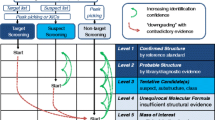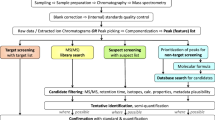Abstract
Sediment cores provide a valuable record of historical contamination, but so far, new analytical techniques such as high-resolution mass spectrometry (HRMS) have not yet been applied to extend target screening to the detection of unknown contaminants for this complex matrix. Here, a combination of target, suspect, and nontarget screening using liquid chromatography (LC)-HRMS/MS was performed on extracts from sediment cores obtained from Lake Greifensee and Lake Lugano located in the north and south of Switzerland, respectively. A suspect list was compiled from consumption data and refined using the expected method coverage and a combination of automated and manual filters on the resulting measured data. Nontarget identification efforts were focused on masses with Cl and Br isotope information available that exhibited mass defects outside the sample matrix, to reduce the effect of analytical interferences. In silico methods combining the software MOLGEN-MS/MS and MetFrag were used for direct elucidation, with additional consideration of retention time/partitioning information and the number of references for a given substance. The combination of all available information resulted in the successful identification of three suspect (chlorophene, flufenamic acid, lufenuron) and two nontarget compounds (hexachlorophene, flucofuron), confirmed with reference standards, as well as the tentative identification of two chlorophene congeners (dichlorophene, bromochlorophene) that exhibited similar time trends through the sediment cores. This study demonstrates that complementary application of target, suspect, and nontarget screening can deliver valuable information despite the matrix complexity and provide records of historical contamination in two Swiss lakes with previously unreported compounds.






Similar content being viewed by others
References
Chiaia-Hernandez AC, Krauss M, Hollender J (2012) Screening of lake sediments for emerging contaminants by liquid chromatography atmospheric pressure photoionization and electrospray ionization coupled to high resolution mass spectrometry. Environ Sci Technol 47:976–986
Peck AM, Linebaugh EK, Hornbuckle KC (2006) Synthetic musk fragrances in Lake Erie and Lake Ontario sediment cores. Environ Sci Technol 40:5629–5635
Löffler D, Ternes TA (2003) Determination of acidic pharmaceuticals, antibiotics and ivermectin in river sediment using liquid chromatography-tandem mass spectrometry. J Chromatogr A 1021:133–144
Ferrer I, Hennion M-C, Barceló D (1997) Immunosorbents coupled on-line with liquid chromatography/atmospheric pressure chemical ionization/mass spectrometry for the part per trillion level determination of pesticides in sediments and natural waters using low preconcentration volumes. Anal Chem 69:4508–4514
Reddy CM, Quinn JG, King JW (2000) Free and bound benzotriazoles in marine and freshwater sediments. Environ Sci Technol 34:973–979
Schwarzenbach RP, Escher BI, Fenner K, Hofstetter TB, Johnson CA, von Gunten U, Wehrli B (2006) The challenge of micropollutants in aquatic systems. Science 313:1072–1077
Giger W (2002) Dealing with risk factors. Eawag News 53e:3–5
Krauss M, Singer H, Hollender J (2010) LC-high resolution MS in environmental analysis: from target screening to the identification of unknowns. Anal Bioanal Chem 397:943–951
Hernández F, Sancho JV, Ibáñez M, Abad E, Portolés T, Mattioli L (2012) Current use of high-resolution mass spectrometry in the environmental sciences. Anal Bioanal Chem 403:1251–1264
Ibáñez M, Sancho JV, Hernández F, McMillan D, Rao R (2008) Rapid non-target screening of organic pollutants in water by ultraperformance liquid chromatography coupled to time-of-light mass spectrometry. TrAC Trends Anal Chem 27:481–489
Hogenboom AC, van Leerdam JA, de Voogt P (2009) Accurate mass screening and identification of emerging contaminants in environmental samples by liquid chromatography–hybrid linear ion trap Orbitrap mass spectrometry. J Chromatogr A 1216:510–519
Nurmi J, Pellinen J, Rantalainen A-L (2012) Critical evaluation of screening techniques for emerging environmental contaminants based on accurate mass measurements with time-of-flight mass spectrometry. J Mass Spectrom 47:303–312
Bueno MJM, Agüera A, Hernando MD, Gómez MJ, Fernández-Alba AR (2009) Evaluation of various liquid chromatography-quadrupole-linear ion trap-mass spectrometry operation modes applied to the analysis of organic pollutants in wastewaters. J Chromatogr A 1216:5995–6002
Bobeldijk I, Vissers JPC, Kearney G, Major H, van Leerdam JA (2001) Screening and identification of unknown contaminants in water with liquid chromatography and quadrupole-orthogonal acceleration-time-of-flight tandem mass spectrometry. J Chromatogr A 929:63–74
Schymanski EL, Singer HP, Longrée P, Loos M, Ruff M, Stravs MA, Ripollés Vidal C, Hollender J (2014) Strategies to characterize polar organic contamination in wastewater: exploring the capability of high resolution mass spectrometry. Environ Sci Technol 48:1811–1818
Moschet C, Piazzoli A, Singer H, Hollender J (2013) Alleviating the reference standard dilemma using a systematic exact mass suspect screening approach with liquid chromatography-high resolution mass spectrometry. Anal Chem 85:10312–10320
Martínez Bueno MJ, Agüera A, Gómez MJ, Hernando MD, García-Reyes JF, Fernández-Alba AR (2007) Application of liquid chromatography/quadrupole-linear ion trap mass spectrometry and time-of-flight mass spectrometry to the determination of pharmaceuticals and related contaminants in wastewater. Anal Chem 79:9372–9384
Thurman EM, Ferrer I, Zweigenbaum JA, García-Reyes JF, Woodman M, Fernández-Alba AR (2005) Discovering metabolites of post-harvest fungicides in citrus with liquid chromatography/time-of-flight mass spectrometry and ion trap tandem mass spectrometry. J Chromatogr A 1082:71–80
HighChem (2014) Mass frontier, version 6.0. HighChem Ltd./Thermo Fisher Scientific, Bratislava
ACD (2013) MS fragmenter. Advanced Chemistry Development Inc., Toronto
Wolf S, Schmidt S, Müller-Hannemann M, Neumann S (2010) In silico fragmentation for computer assisted identification of metabolite mass spectra. BMC Bioinform 11:148
Kanehisa M, Goto S, Sato Y, Kawashima M, Furumichi M, Tanabe M (2014) Data, information, knowledge and principle: back to metabolism in KEGG. Nucleic Acids Res 42:199–205
NCBI (2014) PubChem http://pubchem.ncbi.nlm.nih.gov/, National Center for Biotechnology Information, USA. Accessed 21 Mar 2014
RSC (2014) ChemSpider http://www.chemspider.com/, Royal Society of Chemistry, UK. Accessed 21 Mar 2014
Allen F, Greiner R, Wishart D (2014) Competitive fragmentation modeling of ESI-MS/MS spectra for putative metabolite identification. Metabolomics. doi:10.1007/s11306-014-0676-4
Horai H, Arita M, Kanaya S, Nihei Y, Ikeda T, Suwa K, Ojima Y, Tanaka K, Tanaka S, Aoshima K, Oda Y, Kakazu Y, Kusano M, Tohge T, Matsuda F, Sawada Y, Hirai MY, Nakanishi H, Ikeda K, Akimoto N, Maoka T, Takahashi H, Ara T, Sakurai N, Suzuki H, Shibata D, Neumann S, Iida T, Funatsu K, Matsuura F, Soga T, Taguchi R, Saito K, Nishioka T (2010) MassBank: a public repository for sharing mass spectral data for life sciences. J Mass Spectrom 45:703–714
HighChem (2014) mzCloud https://mzcloud.org, HighChem Ltd., Bratislava, Slovakia. Accessed 31 Mar 2014
Smith CA, O’Maille G, Want EJ, Qin C, Trauger SA, Brandon TR, Custodio DE, Abagyan R, Siuzdak G (2005) METLIN: a metabolite mass spectral database. Ther Drug Monitor 26(6):747–751
Schymanski EL, Meringer M, Brack W (2011) Automated strategies to identify compounds on the basis of GC/EI-MS and calculated properties. Anal Chem 83:903–912
Virtual Computational Chemistry Laboratory (VCCLAB) (2005) http://www.vcclab.org. Accessed 9 Mar 2014
Kern S, Fenner K, Singer HP, Schwarzenbach RP, Hollender J (2009) Identification of transformation products of organic contaminants in natural waters by computer-aided prediction and high-resolution mass spectrometry. Environ Sci Technol 43:7039–7046
Loos M, Ruff M, Singer H. enviMass version 1.2 target screening software, http://www.eawag.ch/forschung/uchem/software/enviMass1_2. Accessed 9 Mar 2014
Van Leeuwen SPJ, de Boer J (2007) Extraction and clean-up strategies for the analysis of poly- and perfluoroalkyl substances in environmental and human matrices. J Chromatogr A 1153:172–185
Liechti P, Der Zustand der Seen in der Schweiz (1994) Bundesamt für Umwelt, Wald und Landschaft BUWAL: Bern
Little J, Cleven C, Brown S (2011) Identification of “known unknowns” utilizing accurate mass data and chemical abstracts service databases. J Am Soc Mass Spectrom 22:348–359
Beller HR, Simoneit BRT (1988) Hexachlorophene distributions in estuarine sediments. Bull Environ Contam Toxicol 41:645–650
Antonic J, Heath E (2007) Determination of NSAIDs in river sediment samples. Anal Bioanal Chem 387:1337–1342
Cole RB, Zhu J (1999) Chloride anion attachment in negative ion electrospray ionization mass spectrometry. Rapid Commun Mass Spectrom 13:607–611
Mathis JA, McCord BR (2005) The analysis of high explosives by liquid chromatography/electrospray ionization mass spectrometry: multiplexed detection of negative ion adducts. Rapid Commun Mass Spectrom 19:99–104
Zhu J, Hou Y, Feng Y-l, Shoeib M, Harner T (2008) Identification and determination of hexachlorocyclopentadienyl-dibromocyclooctane (HCDBCO) in residential indoor air and dust: a previously unreported halogenated flame retardant in the environment. Environ Sci Technol 42:386–391
EnviPat Web 1.3 (2013) Isotopic pattern and profile calculator. Eawag, Dübendorf http://www.envipat.eawag.ch/index.php
Tomlin CDS (1995) The pesticide manual, 10th edn. Royal Society of Chemistry, Cambridge, and British Crop Protection Council, London
Acknowledgments
The authors are grateful for the assistance provided by Birgit Beck (sediment analysis), Martin Loos (enviMass), Lee Ferguson (input in suspect and nontarget screening), Martin Frey (R), Markus Moest, Piet Spaak, and Flavio Anselmetti (sediment core collection). Funding from the Swiss National Science Foundation (SNF CR32I3_125211), the European Union (Marie Curie Inter-European Postdoctoral Fellowship Grant No. 299734), and the Swiss Federal Office for the Environment is gratefully acknowledged.
Author information
Authors and Affiliations
Corresponding author
Electronic supplementary material
Below is the link to the electronic supplementary material.
ESM 1
(PDF 1.70 MB)
Rights and permissions
About this article
Cite this article
Chiaia-Hernandez, A.C., Schymanski, E.L., Kumar, P. et al. Suspect and nontarget screening approaches to identify organic contaminant records in lake sediments. Anal Bioanal Chem 406, 7323–7335 (2014). https://doi.org/10.1007/s00216-014-8166-0
Received:
Revised:
Accepted:
Published:
Issue Date:
DOI: https://doi.org/10.1007/s00216-014-8166-0




